Third Day of Expert Testimony
Today, expert witness Alexander Hinton stood his third day of testimony in front of the ECCC. He was cross-examined by Nuon Chea defense counsel Victor Koppe about his sources and explained his understanding of the treatment of the Vietnamese. He reiterated the position he had elaborated on yesterday by saying that genocide of the Vietnamese took place under Democratic Kampuchea. He stressed continuously throughout the day that one had to give account to spatial and temporal variations. The day was marked by numerous objections by the Co-Prosecution and tensions between the Nuon Chea Defense Counsel and the expert.
Sources of the expert
National Judge You Ottara was absent and replaced by Thou Mony. All other parties to the case were present and Nuon Chea followed the hearing from the holding cell.
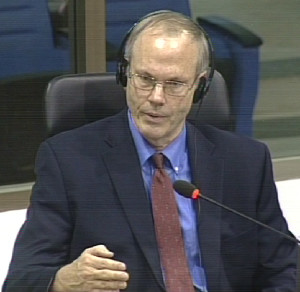
Expert Alexander Hinton
As a point of clarification, Deputy Co-Prosecutor William Smith requested the ERN numbers for the part of the speech by late King Father Sihanouk in which Mr. Koppe had said he mentioned “land-swallowing yuon”.[1] Mr. Koppe replied that he had not implied yesterday that late King Father Sihanouk use this terms but had only talked about it in conditional terms. He then apologized for having said that the Prosecution had not requested the person who they believed to be Teap and had in fact a number (2-TCW-884). As his last preliminary remark, he requested Professor Hinton to answer more slowly and shorter.
Mr. Koppe then wanted to know whether Lor could be Him Huy or a person Him Huy refers to as Teng. Professor Hinton replied that he would have to check the records again to see whether he was able to reveal the individual’s name in order to protect the human rights of that person. Next, Mr. Koppe referred to the list of persons that Professor Hinton had referred to in the beginning of his books. Mr. Koppe said that there were only a handful of people who Professor Hinton had interviewed (since the others listed there were deceased) that were listed (Chlat, Khel, Lor, Neari, Oum Chhan, Teap, Ung Pech, Vaen Kheuan, Van Nath, and Vong).
Moreover, there were a few other individuals.[2] Professor Hinton clarified that he had talked to the experience of the people in every household in Banyan village. He had conducted interviews with hundreds of people, not all of which were included in the book. He recognized the work done by DC-Cam and their archives that provided a lot of information. As for key informants he said that anthropologists had a different approach than other researchers, which is why he did not want to determine the number of key informants. He had interviewed around half a dozen people more than three times. Moreover, an enormous amount of what he had written in his book was also available on the case file through other interviews. There were at least ten to twenty people more than once. He conducted one-time interview lasting between 30 minutes and two hours with around 150-200 people. Outside of this, there was a much larger pool of everyday conversations, since he was living in the village. Mr. Koppe referred to another document and asked him to comment on the quote.[3] Professor Hinton replied that the situation was different in 1994 and 1995, because the Khmer Rouge were still fighting at the time.
Mr. Koppe said that he counted a total of 44 documents that Professor Hinton had used that could be divided into four or five groups (8 US foreign broadcast information service documents, 7 confessions, 6 Revolutionary Flags, 4 or 5 Democratic Kampuchea documents, some microfilm documents, and 7 or 8 DC-Cam documents).
Professor Hinton replied that this seemed to be broadly accurate. He said that he had reviewed more documents that he had mentioned in the book, but had cut them out, because it seemed to be repetitive. Mr. Koppe said that he had also not used more sources in his dissertation. He moved on and asked about ascertaining the validity and reliability of the confessions. He answered that his research was more time-consuming at the time, since there was no online-system he could search in. He had not relied on the content of the confessions, but more on the structure of them. For the times that he had used the content he had relied on the triangulation method.
Mr. Koppe said that he had noted that the expert had not used DC-Cam interviews from people who could have known things about rebellion and wanted to know whether this was correct. He replied that he had used DC-Cam documents, such as confessions and Democratic Kampuchea documents. He stressed the amount of information that was available at DC-Cam.
Mr. Koppe moved on and read a few excerpts of the late King Father Sihanouk speech he had referred to yesterday. [4] In these excerpts he titled the Socialist Republic of Vietnam as having “decided cold-bloodedly […] to swallow Kampuchea” and drew a comparison to a “starving boa constrictor” that was swallowing an animal. In another paragraph, the late King Father Sihanouk said that Vietnam “succeeded in swallowing a good half of Kampuchea” and said that it was similar to the German style blitzkrieg. Mr. Koppe asked whether he was able to give a reaction to the speech by late King Father Sihanouk that portrayed Vietnam as the enemy. Professor Hinton first paid his respect to late King Father Sihanouk and then pointed out that he had not used the word yuon. He said that you had to take the speech in the context of the conflict having just ended. If reading the words that Mr. Koppe had read were completely different to the ones used in the documents that were presented in court before. He confirmed that he thought that late King Father Sihanouk might have been pressured to use the words such as land-swallowing, but told Mr. Koppe to consult an expert for this.
Mr. Koppe then referred to a report by Douglas Pike on Vietnam of October 1978 to the US Congress. He had talked about a possible invasion of Vietnam.[5] He replied that there was a logic to what they were saying and that to portray them as irrational would be a mistake. That there was a logic did not mean that it was historically accurate. Mr. Koppe asked whether his testimony was not a reflection on what was going to happen three months later. Professor Hinton replied that he doubted that the invasion by Vietnam was surprising, since there had been intelligence information.
When Mr. Koppe continued putting questions about the foreign policy of Vietnam, Mr. Smith interjected and said that he observed that the questions seemed to be outside the scope of Professor Hinton’s expertise. Mr. Koppe pointed to another document by Ben Kiernan that the parties could review during the break.[6]
Perception of Vietnam’s policy by China and Cambodia
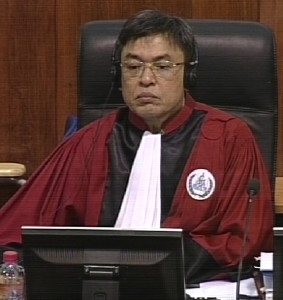
Trial Chamber President Nil Nonn
At the beginning of the next session, Trial Chamber President Nil Nonn asked whether Mr. Koppe had included the document D269/5.1 into the case file. Mr. Koppe denied this and requested this document to be admitted under 87(4). Mr. Smith responded to this request by asking about the relevance of this document. International Civil Party Lead Co-Lawyer Marie Guiraud said that the document had been admitted (E3/9686) and not included on the interface list, but that the questions did not seem to be relevant. Mr. Koppe said it was “terribly important” not to separate Vietnam’s actions from how the treatment of ethnic Vietnamese were seen.
Mr. Koppe said that the team had informed him that there was a video of a speech in the early 1980s of late King Father Sihanouk, in which he had referred to A-Vietnam (contemptible Vietnam) and “the crocodile”. Judge Fenz ordered Mr. Koppe not to discuss this document, since it was not on the case file and not verifiable for the court.
Judge Jean-Marc Lavergne clarified that only six pages of E3/9686 had been admitted and not the one Mr. Koppe intended to use. In this light, Mr. Smith objected to the use of this document in the light of relevance and timing. Mr. Koppe replied that the document had been on the case file since March 2010. Khieu Samphan Defense Counsel Anta Guissé argued that Hinton was scheduled only a month ago, and since he was an expert and the document connected to Ben Kiernan, there should not be any problem in admitting the document.
When Mr. Koppe asked whether he knew who Deng Xiaoping was, Mr. Smith interjected and said that counsel had made statements about facts and then presented another question to the expert. Mr. Koppe repeated his question. Professor Hinton said that he knew Deng Xiaoping. He then proceeded to list a number of scholars he had relied upon.
Mr. Koppe said that he had the feeling he was reading Ben Kiernan and Chandler when reading Professor Hinton’s book. He gave the example of the terms “real and perceived enemies” and “paranoia” that he had used. Professor Hinton said that he drew his conclusions on a wide range of sources and had used the term paranoia in a different meaning than other scholars.
Mr. Koppe said that Deng Xiaoping had referred to Vietnam as the “hooligans of the east” and wanted to know whether this was a racist vision. Professor Hinton replied that he could not comment on this without the context. He said that he needed more specific references. He noted that Mr. Koppe had sometimes said that the expert could not answer specific questions, because he was “just an anthropologist” while he felt that he was supposed to be a “foreign policy expert”. He told Mr. Koppe that he could “not have it both ways”.
Mr. Koppe referred to a 1979 Standing Committee Member Report of the Chinese Communist Party that, in the defense’s view, represented how China viewed Vietnam.[7] He asked for the expert’s reaction of these Chinese perceptions of Vietnamese foreign policy towards Democratic Kampuchea. He replied that this may well have been the perceptions and a fear of the CPK leadership. The word yuon could be used for both Vietnamese civilians and not.
Professor Hinton then explained that purges went through different phases. When war escalated with Vietnam in 1978, Vietnamese people were increasingly targeted. The element of racism had been present before, but increased over time. He said that the leadership perceived the threat by Vietnam as real, but that they were not always historically accurate. The CPK, nevertheless, should not be seen as a passive country, but rather as an active actor that also provoked Vietnam.
Mr. Koppe then asked whether there was a “huge difference” between how Germany perceived and treated Jews and how Democratic Kampuchea treated Vietnamese. Professor Hinton replied that there was a difference, but that just because something did not look like the holocaust did not mean that it was not genocide. He said that people had been stigmatized and disempowered by a bureaucratic control and differences manufactured, which was a “direct parallel” between several genocidal regimes. He said that everything pointed towards the conclusion that genocide of the Vietnamese had taken place.
Mr. Koppe then gave four examples that the expert was asked to characterize whether genocide took place.
First, he wanted to know whether the mass internment of Japanese people in the US under de-humanizing conditions could be considered genocide. At this point, there was a brief discussion about Professor Hinton’s expertise, since Mr. Koppe had said that his expertise was not using consistent definitions, with which Mr. Smith disagreed. Professor Hinton replied that he was not an expert on the massive internment of the Japanese. In the field of genocide study this case was rarely mentioned, but more research needed to be done.
Second, Mr. Koppe asked about people of Chinese origin in the Socialist Republic of Vietnam and great number of deaths of refugees. Professor Hinton answered that the situation seemed to have been “lukewarm” with priming being present, but not all factors activated yet.
Third, Professor Hinton said that the massive killing of half a million Indonesian communists as backed by the CIA was often considered a case of genocide in the field under the 1946 resolution.
Fourth, he told the court that there was a possibility that the treatment of the Vietnamese under Lon Nol could be considered genocide, but that it deserved more attention. Lastly, the expert said that the mass killing in East Timor in 1975 was often discussed as genocide.
Before the Chamber adjourned for a lunch break, Ms. Guissé said that the expert should be provided with a folder of documents during the break that she would use during her cross-examination.[8]
Distinction between Vietnamese civilians and Vietnamese foreign policy
After the break, the floor was handed back to the Nuon Chea Defense Counsel. Mr. Koppe said that he had tried to establish beforehand that Vietnam was “rightfully considered” as a present danger to Cambodian sovereignty form at least 17 April 1975 by Democratic Kampuchea, China and other countries. When the Democratic Kampuchea leaders used the term yuon, Mr. Koppe said the expert had stated, they did not use it in a derogatory way and clearly referred to Vietnam’s foreign policy and that Vietnamese were rightfully seen as traitorous. Mr. Koppe then referred to another Revolutionary Flag of September 1978 in which there was a clear distinction made between Vietnamese civilians and Vietnamese policy and in which there was reference to aggressions by Vietnam was made.[9] Judge Fenz interjected and said that the question had nothing to do with his summary – it should therefore be asked whether this summary was accurate. Mr. Koppe did so and asked for reaction to the excerpt he had read.
The expert said that the summary Mr. Koppe had provided was more a summary of his own understanding and not the one by the expert. He did note that there were temporal and spatial variations and sequences. As for the excerpt Mr. Koppe had read, he was not sure about the context of the document and that he did not know which groups in particular the document referred to.
Mr. Koppe said that his point was that in all speeches there was an effort made to distinguish between Vietnamese civilians and enemies.
Mr. Koppe referred to the testimony of a 164 cadre. [10] This excerpt, Mr. Koppe said, showed that there was a clear distinction made between Vietnamese civilians, fishermen, and the enemy. He wanted to hear the expert’s reaction. The expert replied that some individuals might be confused about orders on the ground and were not sure how to implement orders they had received.
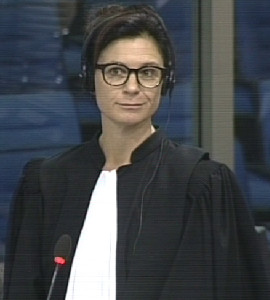
International Civil Party Lead Co-Lawyer Marie Guiraud
At this point, International Civil Party Lead Co-Lawyer Marie Guiraud interjected and said: “Until I’m proven the contrary, the expert is Hinton and not counsel Koppe.” She requested the President to remind counsel to stop pleading.
Mr. Koppe moved to his next topic, namely whether there were internal enemies. He referred to a DC-Cam interview of division 310 combatant Sem Hoeun, who had said that Oeun hid weapons in Kampong Cham.[11] He said that this showed that there was an armed rebellion taking place, followed by a coup. He wanted to know whether the expert had heard of this. Mr. Smith objected, saying that they disagreed on with the characterization of the evidence. The expert wanted to know which years the defense lawyer was talking about. Mr. Koppe said that it was in 1975, 1776 or 1977. Professor Hinton said that he assumed that there were some rebellions sometimes, as also showed by his example of Teap, who tried to rebel.
Mr. Koppe then said that Heng Samrin had said that they “had a struggle, but a secret one” in 1976 and 1977.[12] When he asked for reaction to this statement, Mr. Smith objected and said it was difficult to give a reaction to this without any context. Mr. Koppe asked whether there was a plan to rebel in 1976 or 1977. Mr. Smith objected again, saying that this misrepresented the evidence presented.
Mr. Koppe asked whether he had heard of a plan to rebel by the Vietnamese Workers Party in 1978, including a plan to have a rebellion led by Sao Phim, and if that did not work out, invade the country. Professor Hinton replied that he had come across this in court documents, but not through his informants. He said that he was looking forward to the judgment to clarify historical understanding.
Mr. Koppe said that he was not referring to any S-21 documents or confessions but instead to the works by Nyan Chanda, and William Duiker.[13] They had talked about resistance movements and the support of Vietnam in these rebellions in 1978. Professor Hinton said that it would have been good to have been given marked documents beforehand. He said that this was a possibility that there had been such a plan and that he would not be surprised by this. When Mr. Koppe asked whether he was therefore not disputing that such a plan existed by the Vietnamese Workers Party, Mr. Smith objected and said that the expert had already said that it might have been a possibility and could not go further than that. Professor Hinton said that one had to look at the historical context and change over time, and that this might have been a possibility in light of this.
Mr. Koppe then wanted to know what he meant when saying that the party center was led only by “paranoia” when speaking about arrests. He answered that he had not said that they were “only” driven by paranoia. However, there was evidence that the regime became increasingly paranoid, due to which many people were purged. This resulted in the targeting of ethnic Cham and ethnic Vietnamese as well as suspected Khmer class enemies. This idea of paranoia was fairly uncontested. To say that they were acting out of paranoia would be incorrect, since they reacted to real or perceived threats.
Mr. Koppe then referred to the book by Chanda, who had talked about the visit by Soviet general Pavlovski to Laos, meeting with Vietnamese officials and saying that they should “do the Czechoslovakia”. The expert replied that this idea to overthrow the government might have existed.
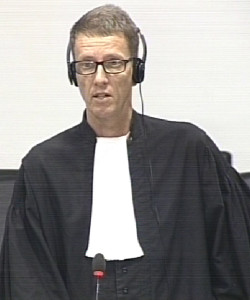
International Nuon Chea Defense Counsel Victor Koppe
When Mr. Koppe asked whether he stood still by his statement that Vietnam was no real threat, Mr. Smith objected and said that this had not been the position of the expert. Mr. Koppe referred to the expert’s book and asked for reaction. [14] Professor Hinton replied that it was too easy to say that Vietnam was a real enemy from 1975 until 1979 as if that had not changed over time. There could be paranoia that was based on real events. It was important not to draw standardized and rigid conclusions but to take into account spatial and periodic changes. He refused the allegation that he had presented a reductionist argument in his book by talking about paranoia.
Mr. Koppe read an excerpt of a Revolutionary Flag and a book.[15] These excerpts dealt with New People and their revolutionary consciousness. These documents were dated 1976, 1977 and 1978. Professor Hinton said that there were temporal variations and that the element of paranoia emerged over time.
Mr. Koppe asked him to compare the propaganda he had read to the Nazi propaganda of Der Stürmer or the radio broadcasts in Rwanda and asked how these “even relate” to each other. The expert said that there were many documents that showed de-humanizing discourse and it was therefore accurate to draw a comparison between the Nazi regime, Rwanda, and Democratic Kampuchea regime. When Mr. Koppe asked him to give one document that said that New People had to be persecuted or Vietnamese people should be killed, the expert said that he had not prepared to bring any documents today, but started referring to some documents. Mr. Koppe interrupted him and repeated the question, at which point Mr. Smith interjected and said that counsel should give the expert the opportunity to answer the question.
Khieu Samphan Defense Team: methods of research
After the last break, the floor was given to the Khieu Samphan Defense Team. Professor Hinton said that when going to Cambodia in 1992, he thought he was going to investigate local perceptions of psychology, but this had changed when coming back in 1994. It was important to understand the cultural patterns of violence. Ms. Guissé asked more detail about his field work. He replied that he spent around 11 months in Kampong Siem district and stayed in Phnom Penh for around a year. He could not go to the Southwest, since the Khmer Rouge were still active at that time and had captured some foreigners and executed them. She wanted to know when she took Khmer lessons and for how long. He replied that he took the beginner, intermediate and advanced Khmer lesson classes at an institute. He took this training during three summers. He came back for shorter periods of time after this time, ranging from one to three weeks.
She asked what sources he relied upon when writing the book. He answered that the bulk of information came from his research in Kampong Siem and Kampong Cham. In 1992, he went for around three months in Phnom Penh.
He came back a few times and more regularly during the course of the Duch trial and on average for two weeks.
She wanted to know whether a result of the research that he carried out during these years, he had not the same experience during the time in Kampong Siem and Kampong Cham. He answered that his research projects were different. She wanted to know whether he did not specifically go there to research the treatment of the Cham or the Vietnamese. He replied that he was “aware of the genocide of the Cham” at the time and noted it when they mentioned it, but he did not undertake a study of the genocide of the Cham as Ysa Osman had done.
Ms. Guissé referred to footnote 4 of his book and wanted to know whether he agreed that he based himself on the sociological meaning of the word genocide in his work. He answered that he was now a genocide scholar and that it was therefore not easy to give an answer. He was aware of the Genocide Convention, but his own understanding was more in accordance with the 1946 Resolution. She referred him to endnote 4, in which he had criticized the 1948 UN Convention definition of genocide, since he said it “privileges certain social categories”. [16] He said that the restriction of the protected groups, outside the court of law, was ethnocentric. In his view, genocide occurred when a group was to be destroyed for because of who they are. He confirmed that he stood by his endnote 4 and that many people agreed with him. Saying that the definition was “highly problematic” did not mean to disregard the importance of the existence of the definition.
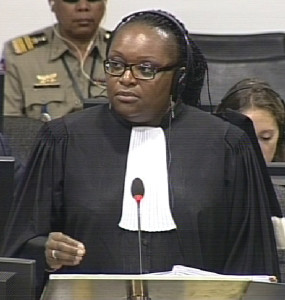
International Khieu Samphan Defense Counsel Anta Guissé
Ms. Guissé turned to the topic about the Vietnamese and inquired about yesterday’s statement that there were very few Vietnamese in Region 41. He clarified that there were points he needed to elaborate on not to give reductive answers. What he meant, he said, was that there were far fewer ethnic Vietnamese than ethnic Cham in the area. She asked whether the research he had done in Region 41 related to the network of Koy Thuon was an important part of his research. He replied that it was indeed an important part and doing research took more time back then.
She then referred to his statement yesterday in which he had mentioned a broadcast about the Cham and wanted to know which radio broadcast he spoke about. She said that they had not been made aware of any radio broadcast directed against the Cham in the key document hearings. He replied that he did not recall having said having relied on a radio broadcast concerned exclusively with the Cham. When she said that the transcript said he referred to this, he insisted that he did not recall having referred to one specific broadcast dealing with the Cham.
She then asked him whether he had also interviewed someone who either worked at Phnom Pros or was connected to it. He answered that he had interviewed this person two or three times. She then wanted to know whether he had interviewed two people who had worked at S-21 and one person who worked at Phnom Pros, which he confirmed. He could not remember where he got the demographic report from. He did not have this document when he conducted his research at first.
Concentration of targeted groups at one place
She said that he had spoken about the notion of concentration of a group in a specific place, which could contribute or facilitate to the control of the group that frequently occurred in times of mass crimes. She asked whether this was correct. He said that he preferred to the term re-organization of difference through concentration as part of a larger process.
She read an excerpt of the witness Man Seng, who had talked about his involvement in a rebellion, denied having been tortured during his interrogation and had been transferred. [17] She wanted to know how he placed this population movement, since it seemed to be more scattering and not concentration. He answered that concentration was one of the forms of regulatory control that was common under Democratic Kampuchea. He said it was one modality and one needed to looks at special and temporal variation. Over time, plans changed. She said that this example showed that they were moved and that this posed a counter-example of people being controlled through concentration and actually integrated into Khmer society. He explained that one modality was concentration, but others included record-keeping.
The President adjourned the hearing. It will continue tomorrow, March 17 2016, at 9 am with the testimony of this expert.
[1] E3/7335.
[2] 00431710-11 (EN) and 00431711 (EN).
[3] E3/9703, p. 2.
[4] E3/7335, at paragraph 65-85. E3/7336R in French.
[5] E3/2370, at 00187396 (EN), 00344747-48 (FR), p. 17.
[6] D269/5.1, at 00488244 (EN), p. 105.
[7] E3/7325, at 01001622 (EN), 01062397 (KH).
[8] E3/123, E3/221, E3/4604, E3/4257 , E3/9935, E3/727
[9] E3/215, pp. 12-13, at 00488625-26 (EN), 00064599-601 (KH), 00524076-77 (FR).
[10] E319/23.3.12, at answer 70.
[11] E3/7516, at 0876520 (EN) 00892665 (FR), 00020598 (KH).
[12] E3/1568, at 0065189 (EN).
[13] E3/2376, at 00192401-02 (EN), 00191550 (KH), 00237830 (FR) and E3/7340.
[14] At 00431538 (EN), 00431606 (EN).
[15] E3/725, at 00184320 (EN), 00064546 (KH), no French translation available and E3/8, Pol Pot Plans the Future, at 00104100 (EN).
[16] 00431743 (EN).
[17] E3/5205 at 00293922 (FR), 00221850 (KH), 00275164 (EN). E3/7675, at 00293926 (FR), 00221859 (EN).
Featured image: Alexander Hinton (ECCC: Flickr).
